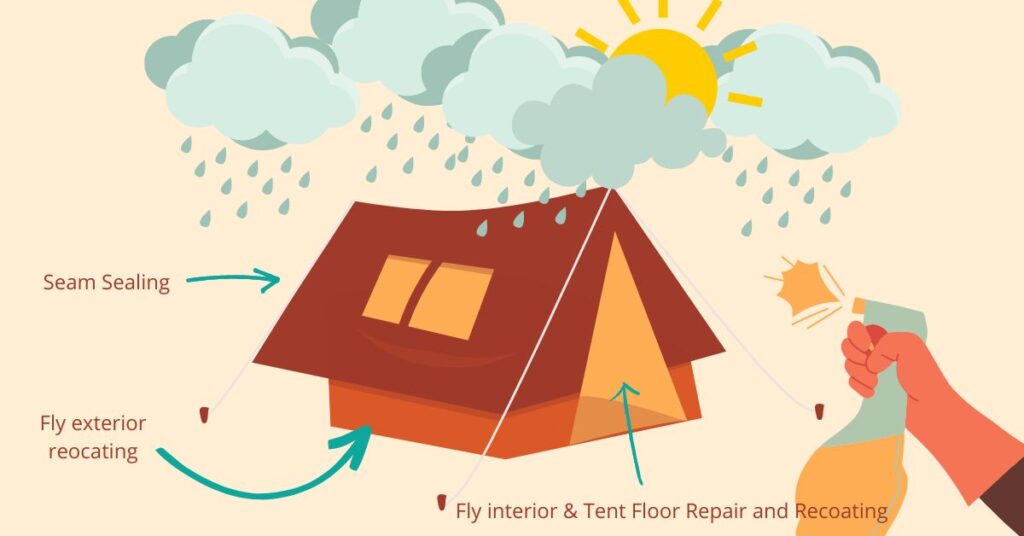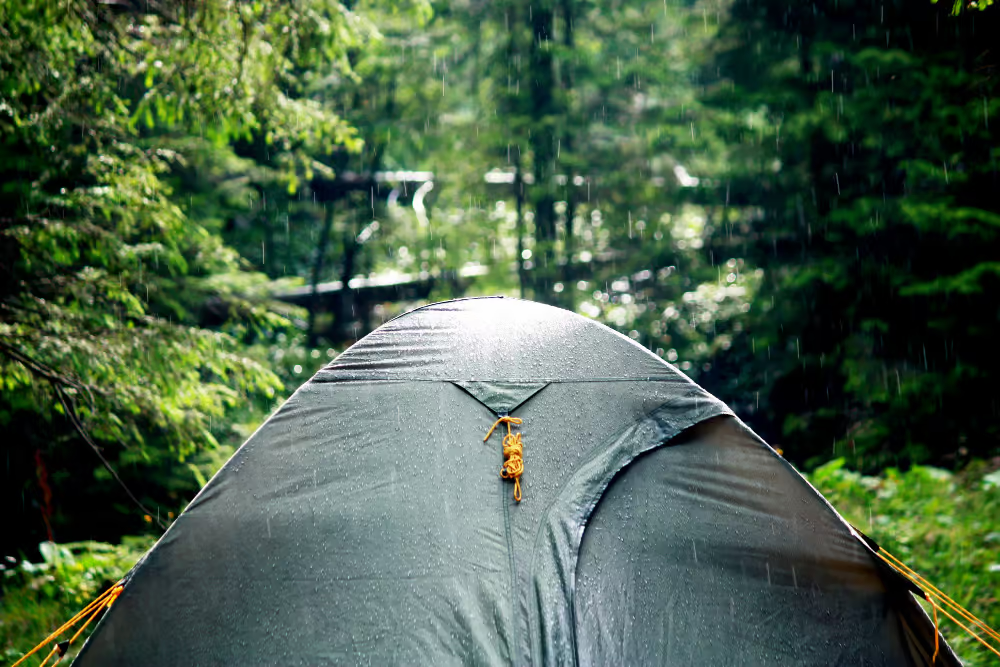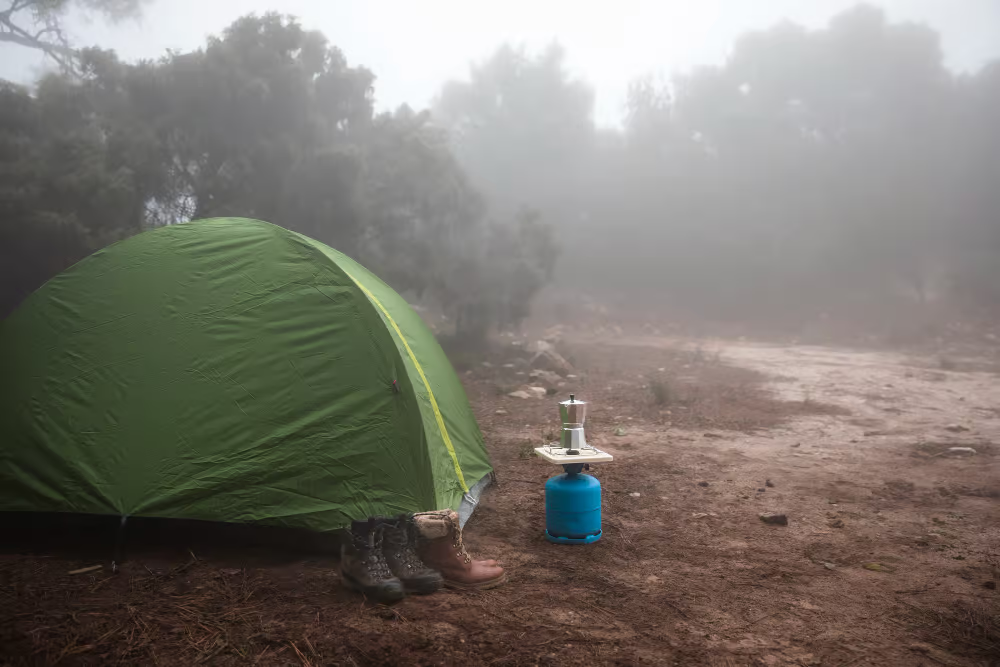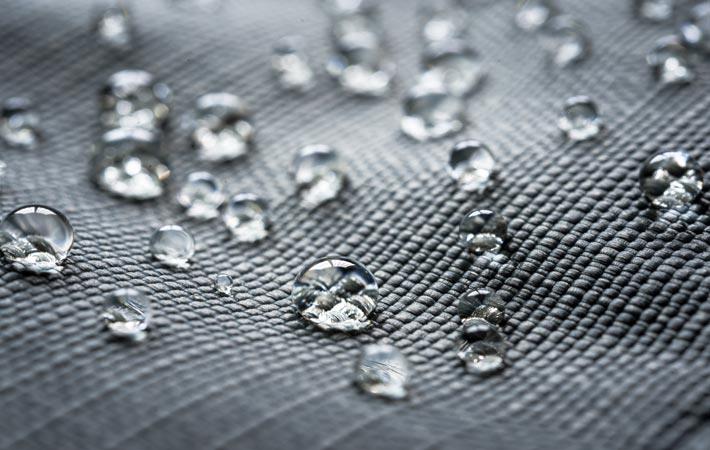
If you don’t prefer camping in the rain because the moisture can ruin your tent, it’s time to change your mind.
Don’t let bad weather stop you from enjoying nature. You can camp at any time of year if you know how to waterproof a tent.
Problems with moisture, coldness, and damage to the material of your tent should become a thing of the past.
Therefore, this article will teach you how to waterproof a tent before you hit the road, so when you arrive at the campsite, you can be completely safe and sleep peacefully in a warm tent.
Table of Contents
What Does “Waterproof” Really Mean?

Water-resistant usually means that the material or object can repel water or doesn’t allow water or moisture to penetrate its surface. You can test how waterproof a tent is based on how long it can be in the water and still be functional.
Depending on the product, you can achieve waterproofing with a coating or other material that prevents water from entering or with a design that channels water from the interior.
Technically, no fabric is 100% waterproof in extreme conditions. However, it will not get wet under normal circumstances if it is usually waterproof.
By the way, you can measure tent waterproofing in millimeters. It corresponds to the maximum amount of water that can fit on top of the fabric without passing through it.
When camping, you must remember other external factors that can cause water to enter the tent and lead to a leaking tent.
For example, there is groundwater, so the ground is naturally moist, so you need to protect the tent floor in particular. I also recommend a ground cloth to prevent additional dirtiness on the floor.
You should have the tent’s fabric from 3000mm to 5000mm to be functionally waterproof.
So, keep all these things in mind if you want to know how to waterproof a tent.
Why Do You Need Tent Waterproofing?
Not all tents are of such good quality that they provide sufficient protection when the wind picks up, and the rain falls. Adding a tent waterproofing treatment will improve its water repellency in this case.
It will help if you waterproof your tent for several reasons to keep you comfortable camping.
Tent waterproofing protects the tent from rain, snow, and other forms of precipitation, as well as damage or weakening of moisture. It extends the tent’s life and ensures it is comfortable and dry. Also, it prevents the formation of condensation on the interior walls.
The three significant factors that can affect lower water resistance are:
Sun damage: UV rays can significantly damage your tent’s fabric from prolonged exposure to the sun. Camping in the summer lasts longer than in the winter, so you expose your tent to more sun.
Although it rains less often in the summer, it is essential to protect your tent with a waterproofing layer so that the sun doesn’t cause permanent damage to the outer layer of the tent. Otherwise, it will not withstand heavy rainfall.
Use and age: If you use the tent frequently, it will accumulate more dirt and dust. Then, you will need to wash it more often and dry it. Its frequent use and need for washing cause water to be absorbed into the fabric, making it less effective against rain and wind. I recommend applying a tent waterproofing treatment by adding a DWR coating to the fabric’s surface to prevent this. The result will surprise you.
Damaged seams: As you use the tent more often, you can damage the tent’s seams. Specifically, gaskets can deteriorate over time and cause leaks at the seams. Adding a seam sealer will solve this problem.
Does Waterproofing a Tent Work?

The answer is yes. The key to waterproofing your tent is to buy a waterproof tent or a tent that already has a waterproof coating.
You must apply a waterproof sealant if you see damage, such as holes.
When Should You Waterproof a Tent?
It would be best to waterproof your tent before you use it for the first time and every few months after that, or as needed, to ensure you have adequately protected it from rain and other elements. Like this, your camping trip will be comfortable.
Are There Any Downsides to Tent Waterproofing?
There are some disadvantages to waterproofing a tent. For example, waterproofing will add weight to the tent, making it difficult to transport.
Also, some tent waterproofing treatments can be pretty smelly when first applied. And some waterproofing treatments can contain chemicals that can harm the environment.
But let’s look at all the tips you will remember when you try to waterproof a tent next time.
Waterproofing Tips
Look for a tent made of a waterproof material such as polyester or nylon, and avoid most tents made of cotton or canvas, which are not waterproof.
Use seam sealer to prevent water ingress.
Ensure you use a rain cover over the tent to keep the rain out.
Place the tent in a location that is free of debris and has good drainage.
Place stones around the perimeter of the tent to prevent water from entering.
Preventively check the tent for signs of damage, as this can lead to leaks.
With all these things in mind, you will make your camping comfortable.
How Does Waterproof Fabric Work?

The waterproof fabric uses different materials and technologies to create a barrier that prevents water from penetrating and soaking the suitable tent fabric.
The most common waterproof fabrics are synthetic materials such as nylon, polyester, and PVC, which are treated with a waterproof coating or laminated with a membrane that blocks the passage of water molecules.
This coating or membrane is usually breathable, allowing air to move through the fabric while retaining moisture.
When you know the functionality and all the advantages of tent waterproofing, let’s move to the most crucial part – how to waterproof the tent.
How To Waterproof a Tent?
Pay attention to the essential outdoor gear to have with you to take care of your tent, from certain waterproofing products to patching or repairing tools.
Most important, carefully follow the next steps you need to take to waterproof your tent.
Identify Problem
I recently bought a new tent and started having problems during the rainy season. The tent was not waterproof, allowing moisture to enter and making sleeping uncomfortable. I had to act as soon as possible to solve the problem and extend my stay.
After surviving a bad experience, I invest in a waterproof tent in time to enjoy the outdoor adventure without worry and stay dry and comfortable.
Based on this, I will give you the proper guidelines for waterproofing your modern tents.
First, identify the problem.
To use suitable treatment and rationally spend money on waterproofing, you need to know which part of your tent you should repair.
To prevent a future camping problem, test the tent before you go and keep these questions as a reminder:
Did I set it up correctly?
Is water dripping through the seams?
Are there wet spots on the entire tent floor?
Does water seep through the main fabric?
Are there any holes in the tent?
When you find the issue, you can move to another step.
Select A Dry Day For Waterproofing Your Tent
Choosing a dry day to waterproof your tent is essential for several reasons.
First, it ensures that the tent will be completely dry when it’s time to apply the waterproofing treatment.
Second, the waterproof treatment will adhere more easily to the tent fabric and last longer in dry weather.
Third, if you waterproof a tent in the rain, the water will prevent the treatment from adhering correctly to the fabric.
So, waterproofing your tent on a dry day will ensure your tent is ready to go and give you the protection you need for the great outdoors. Before taking any other steps, make the tent clean.
Clean and Repair Your Tent
Before you start waterproofing your tent, it’s essential to ensure it’s clean and in good condition. (Check out our guide on how to clean a tent)
You should clean the tent thoroughly with a sponge or damp cloth, mild soap, water bead, water solution, a small brush, and even rubbing alcohol.
Pay special attention to seams, corners, and areas that may harbor dirt and mold. After you clean the abrasive side of your tent, you can check the parts you should repair if necessary.
Afterward, inspect it for wear and tear, such as holes, frayed seams, or faded fabric.
Cleaning and repairing your tent before waterproofing will ensure it’s ready for your next camping trip.
Seal the Tent Seams And Apply Seam Sealant
Placing the tent on an uneven surface may cause damage in the form of holes or tears in certain parts of the tent.
Therefore, sealing your tent’s seams is essential in keeping your tent waterproof and preventing water leaks.
The first step is ensuring your tent seams are clean and free of dirt, debris, and mold. Once the seams are clean, apply sealant with a brush, sponge, damp cloth, or spray bottle. You can use rubbing alcohol for detailed cleaning.
Apply tent sealant and let it dry completely before putting the tent away. You can also use seam tape for better cleaning.
Sealing all the seams properly will help ensure your tent is safe and dry on your next camping trip.
Apply Urethane Coating to Waterproof The Tent Floor And Rain Fly
Keep in mind that you may have two coats for tent protection. Applying a urethane coating for waterproofing the floor and rain is the next step to protect the outer structure of your tent in wet weather. Also, a polyurethane-coated tent is a good option.
A urethane coating is a moisture barrier preventing water from penetrating the fabric or other materials.
Once you have thoroughly cleaned and dried the tent, you can apply the coating. It would be best to allow it to dry for several hours before the rainwater is put in place.
On the other hand, a tent fly, usually called a rain fly, is a waterproof nylon or polyester outer tent layer that provides additional protection from the elements. This outer fly is often combined with a tent print (waterproof backing) for extra protection from the ground.
The rain flies inside are attached to the poles using a series of loops, clips, or ties. It is tied to the bottom of the tent with ropes and stakes, and the sides and top are usually held in place with elastic cords.
Also, a tent fly can help keep the tent cool in hot weather by providing extra ventilation.
Finally, you should check for any signs of water seeping into the tent by dousing the tent with water.
These steps ensure the tent stays dry and comfortable, even in wet weather. So, ensure buying a new coating on time!
Apply A Durable Water Repellent To The Outside Of The Tent Walls
Applying a durable water-repellent material to the outer walls of your tent is an essential step in ensuring the longevity of your waterproofing tents.
Water repellency helps repel water, dirt, and dust. You should do this at least once a year or more if you use the tent frequently. You should apply the water repellent in a thin layer covering the tent walls’ exterior.
It is important to note that the water-repellent material should not be applied to the inside of the tent walls, as this can lead to the formation of condensation.
Dry Out The Tent Fully Before Putting It Away
It is vital to ensure that you have entirely dried your tent before taking any other action, such as applying a coating or spray or putting it in storage.
If you get the tent wet and leave it indoors, mold will grow, damaging the fabric and tent poles.
Therefore, it is essential to take the tents down and lay them out in the sun or in a well-ventilated area to remove all moisture.
Once you have completely dried the tent, store it in a cool, dark place.
You can complete the waterproofing process if you have delicate sprays. So, equip yourself quickly and buy the ideal spray for your tent. Let’s find out!
The Best Waterproof Tent Sprays

When buying waterproof tent sprays, you should consider only those that provide maximum protection against rain and wind. Sprays that you can easily apply and make your tent waterproof are the right choice.
The best tent sprays should contain a mixture of polyurethane coating, silicone, and other waterproofing agents that penetrate the fabric and form a barrier against moisture. The product should be resistant to UV radiation and withstand extreme temperatures.
In addition, it should dry quickly without leaving streaks and bonds to the fabric to provide long-lasting waterproof protection.
Many sprays are available in the market, and they are very affordable. There are also different types of sprays depending on the tents.
One of the well-known waterproofing sprays on the market is DWR spray or DWR coating (Durable Water Repellent) because it protects tent fabric and other materials from water, dirt, and oil.
They form a protective barrier on the fibers, preventing water from penetrating the fabric. They can also help reduce fading caused by harmful UV rays.
Using the correct spray and allowing the fabric to dry completely before use is vital.
DWR spray is easy to use and can provide long-lasting protection.
Let’s see how to waterproof a canvas tent and tent with a tarp to help you decide which spray is the best for your needs.
How to Waterproof a Canvas Tent

In the case of canvas tents, the most crucial step is to purchase waterproofing spray for canvas tents. As with the coating, apply the waterproof spray to a clean tent, and let it dry for a few hours.
The best waterproofing spray for a canvas tent is a silicone-based spray, as they help prevent water and mold from penetrating the tent. It also provides UV protection.
When using these sprays, following the manufacturer’s instructions and applying them every few months is essential.
How to Waterproof a Tent With a Tarp
Before waterproofing the tent, you need to collect enough materials to work with. You will need a waterproof tarp, scissors, tent stakes, and a hammer.
And then, follow these steps:
Set up your tent on a level and safe place
Spread the tarp over the top of the tent
Take the scissors, and cut the tarp into pieces that will fit the different parts of the tent
Place the tarp sections over the tent and secure them with tent pegs. Drive stakes into the wet ground to secure the tarp.
Secure the tarp around the tent to ensure that water cannot enter.
Additional Resources
Ready To Waterproof a Tent?
Although you weren’t sure how to waterproof a tent, you know everything you need to do now.
You know all the problems caused by moisture, so you should protect your whole tent in time to not spoil your camping experience.
You’ve learned what the waterproofing process looks like – from what steps you need to take to waterproof the tent to what sprays you should use.
Nothing can stop you from enjoying camping anymore. Settle in the tent and be carefree.
-
Milica is a nature lover and explorer of the great outdoors. She is always up for the challenge, whether camping, hiking, kayaking, or cycling. For her, exploring nature is a great way to connect with the environment around us and meet new people along the way. She always looks for the next journey and loves sharing her experiences with others. Besides, she loves writing and thus creates exciting stories based on personal experience.
View all posts





